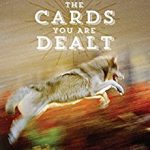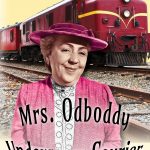Today, Steve Sabatka, talks about growing up watching the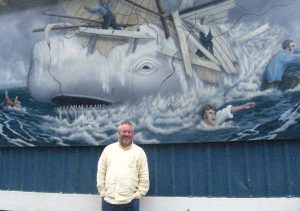 early animated movies when each scene would require twenty-four graphic panels for a single second of a movie. Steve lives in Newport, Oregon and teaches at Newport High School. Steve writes short stories (has won the NETWO short story contest one year) and in 2016, published a young adult novel about teenagers finding a … well, I’d better let Steve tell you.
early animated movies when each scene would require twenty-four graphic panels for a single second of a movie. Steve lives in Newport, Oregon and teaches at Newport High School. Steve writes short stories (has won the NETWO short story contest one year) and in 2016, published a young adult novel about teenagers finding a … well, I’d better let Steve tell you.
- I was five years old, watching that classic old flick, King Kong, and losing my little boy mind. Drum-beating natives. Hungry dinosaurs. Wild, throbbing orchestral music. And a giant gorilla with rolling eyes and great, fearsome teeth – fighting biplanes from atop the highest building in the world. It was better than any three
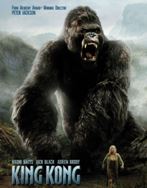 ring circus or screaming carnival ride. But when Kong, shaggy, bleeding, and defeated, let go and fell one hundred and two stories to the Manhattan pavement, I lost it, son, flipped out, crying and screaming so loudly that my dad thought a police car, old-style siren blaring, had pulled up in our front yard. The King was dead and I was not happy about it. Dad consoled my by explaining that Kong wasn’t dead – because he’d never really been alive. It had all been a trick. A special effect.
ring circus or screaming carnival ride. But when Kong, shaggy, bleeding, and defeated, let go and fell one hundred and two stories to the Manhattan pavement, I lost it, son, flipped out, crying and screaming so loudly that my dad thought a police car, old-style siren blaring, had pulled up in our front yard. The King was dead and I was not happy about it. Dad consoled my by explaining that Kong wasn’t dead – because he’d never really been alive. It had all been a trick. A special effect.
In time, I learned that Kong was a puppet, basically, just eighteen inches tall, with metal joints under layers of rubber and trimmed rabbit fur, and that an ex-boxer and newspaper cartoonist named Willis O’Brien brought the mighty ape, to life, one frame of movie film at a time, just like Bugs Bunny or Donald Duck, and that one fleeting second of snarling, chest-beating action required twenty four separate poses, twenty four clicks of the camera shutter. I could imagine Mister O’Brien going off to work every morning – with a briefcase full of toy monsters and dinosaurs – and being paid to play with them all day.
I wanted to be a monster tamer, too. Just like O’Brien and Harryhausen and all the other movie magicians, the names you see at the end of movies like Mighty Joe Young and Jason and the Argonauts and When Dinosaurs Rules the Earth. So I started making my own monsters out of dime store modeling clay – with toothpick points for teeth and eyes that were sucked-down lemon drops – posing them, a millimeter or two at a time, and then snapping off frame after frame of eight millimeter, Kodachrome film.
When the finished film came back from the pharmacy, I would thread up the projector, hit the lights, and then stare, awestruck, as my homemade creatures prowled across the white wall of my bedroom – on their own, as if they had been resurrected from their fossil tombs to growl and shake the earth once more. It was truly magic – and the thing I wanted to do for the rest of my life.
But then, as I got older, something very sad happened – just like in the folk song, “Puff the Magic Dragon.” Clay monsters and dinosaurs made room for other toys. I grew up, went to school, got a job as a school teacher, and pretty much gave up on making monster movies. I also started writing. A lot of short stories. Two bad novels. Strangely, monsters kept cropping up in my stories. Aliens. Dinosaurs, too. I even wrote a very short sequel to King Kong, entitled Fall Guy.
Jurassic Park all but killed the art of stop motion. Made it extinct. And so gone are the days when folks would walk out of a theater after seeing The Seventh Voyage of Sinbad, say, or The Beast From 20,000 Fathoms, asking. “How did they do that?” Everybody knows the three letter answer: CGI. Computer Generated Imagery. Monsters have become nothing more than a file on an ILM desktop.
I miss the old days. And I want younger folks to know about 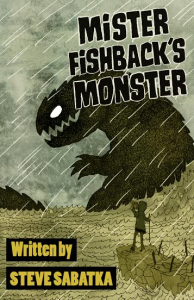 my heroes and all their frame-by-frame voodoo. So I wrote a young adult novel about a teenage monster nerd (me, basically), and his two oddball buddies – a Vietnamese refugee, and a 250 pound wrestler – trying to explain the scaly, hairy, multi-toothed horror that has just washed up dead on the Oregon Coast.
my heroes and all their frame-by-frame voodoo. So I wrote a young adult novel about a teenage monster nerd (me, basically), and his two oddball buddies – a Vietnamese refugee, and a 250 pound wrestler – trying to explain the scaly, hairy, multi-toothed horror that has just washed up dead on the Oregon Coast.
My book, Mister Fishback’s Monster, was recently unleashed on an unsuspecting world by Black Bed Sheet Books, and, from what I’m told, it was their bestselling young adult title for 2016.
The back cover of my book reads like a B-movie poster:
“Ravenous beasts from the dawn of time! Gun packin’ roller derby queens! Chattering freaks, belched up from the ocean floor! Bug-eyed Martian bullies! Political intrigue! Corporate corruption! Bigfoot! Blood! Guts! Pam Grier!”
Mister Fishback’s Monster is funny. A little creepy. And the special effects are amazing.
I hope you’ll check it out. And I hope to hear from my fellow stop motion maniacs. I’ll send a free copy to the person that can tell me (via Facebook) the name of the unsung hero, the amazingly talented man that actually made Kong (and all the other denizens of Skull Island) out of so much rubber and cotton and metal before handing them, lifeless, over to Willis O’Brien.
Postscript:
I was fortunate enough to meet Fay Wray in person several years before she passed. I told her about freaking out when I was a kid and how I had hoped she and Kong would’ve lived happily ever after. Ms. Wray gave me the kind of expression usually reserved for the hopelessly delusional and said, “Surely, now that you’re older, you understand that the relationship was not very practical.”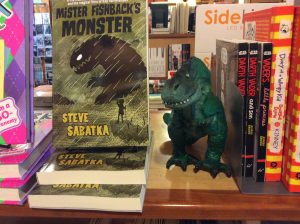
Or something like that.
I guess she was right.
But still.
JIM: We love for you to leave a comment. Thanks.


 16 novels, including six in his Sticks Hetrick crime series, plus a non-fiction regional history. His short stories and articles have been published in a variety of magazines. He is a member of International Thriller Writers and is a past vice president of the Short Mystery Fiction Society. He currently serves as librarian of his county historical society, where he assists patrons with genealogy and research
16 novels, including six in his Sticks Hetrick crime series, plus a non-fiction regional history. His short stories and articles have been published in a variety of magazines. He is a member of International Thriller Writers and is a past vice president of the Short Mystery Fiction Society. He currently serves as librarian of his county historical society, where he assists patrons with genealogy and research
 early animated movies when each scene would require twenty-four graphic panels for a single second of a movie. Steve lives in Newport, Oregon and teaches at Newport High School. Steve writes short stories (has won the NETWO short story contest one year) and in 2016, published a young adult novel about teenagers finding a … well, I’d better let Steve tell you.
early animated movies when each scene would require twenty-four graphic panels for a single second of a movie. Steve lives in Newport, Oregon and teaches at Newport High School. Steve writes short stories (has won the NETWO short story contest one year) and in 2016, published a young adult novel about teenagers finding a … well, I’d better let Steve tell you. ring circus or screaming carnival ride. But when Kong, shaggy, bleeding, and defeated, let go and fell one hundred and two stories to the Manhattan pavement, I lost it, son, flipped out, crying and screaming so loudly that my dad thought a police car, old-style siren blaring, had pulled up in our front yard. The King was dead and I was not happy about it. Dad consoled my by explaining that Kong wasn’t dead – because he’d never really been alive. It had all been a trick. A special effect.
ring circus or screaming carnival ride. But when Kong, shaggy, bleeding, and defeated, let go and fell one hundred and two stories to the Manhattan pavement, I lost it, son, flipped out, crying and screaming so loudly that my dad thought a police car, old-style siren blaring, had pulled up in our front yard. The King was dead and I was not happy about it. Dad consoled my by explaining that Kong wasn’t dead – because he’d never really been alive. It had all been a trick. A special effect. my heroes and all their frame-by-frame voodoo. So I wrote a young adult novel about a teenage monster nerd (me, basically), and his two oddball buddies – a Vietnamese refugee, and a 250 pound wrestler – trying to explain the scaly, hairy, multi-toothed horror that has just washed up dead on the Oregon Coast.
my heroes and all their frame-by-frame voodoo. So I wrote a young adult novel about a teenage monster nerd (me, basically), and his two oddball buddies – a Vietnamese refugee, and a 250 pound wrestler – trying to explain the scaly, hairy, multi-toothed horror that has just washed up dead on the Oregon Coast.
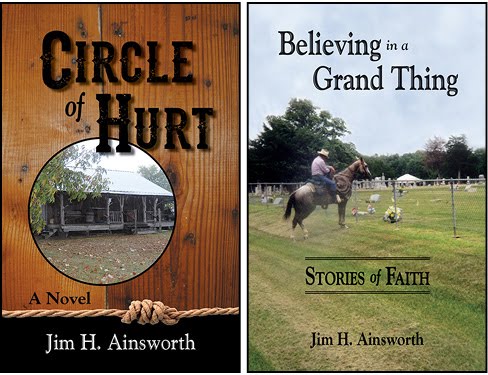
 but especially mystery and fantasy.
but especially mystery and fantasy. because she wanted to go as the headless horseman for Halloween. I know how she defends those being bullied, her soft spot for animals, and how much she loves settling in front of a fire with a cup of hot cocoa. She’s a person I’d really like to hang out with.
because she wanted to go as the headless horseman for Halloween. I know how she defends those being bullied, her soft spot for animals, and how much she loves settling in front of a fire with a cup of hot cocoa. She’s a person I’d really like to hang out with. Another thing I love is when a character just appears and refuses to disappear. While writing Dragons of Jade, I was typing along in the groove, and a dog appeared in a scene. I didn’t want a dog in the book so backspaced and deleted him. A few sentences later, my character opened the door and in bounded the dog. He had a name, a personality, and I knew exactly what he looked like. I thought about deleting him again but just couldn’t. Turns out, he was an important part of the story.
Another thing I love is when a character just appears and refuses to disappear. While writing Dragons of Jade, I was typing along in the groove, and a dog appeared in a scene. I didn’t want a dog in the book so backspaced and deleted him. A few sentences later, my character opened the door and in bounded the dog. He had a name, a personality, and I knew exactly what he looked like. I thought about deleting him again but just couldn’t. Turns out, he was an important part of the story. heir jobs, their culture, and just what makes them tick. Then, we hang out in front of the fireplace sipping hot cocoa and telling stories.
heir jobs, their culture, and just what makes them tick. Then, we hang out in front of the fireplace sipping hot cocoa and telling stories.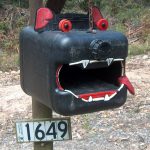 fifty miles across the Bass Strait from Melbourne, Australia. It was discovered in 1642 by a Dutchman named Abel Tasman, but there were a number of Aboriginal tribes there when the British came to settle it in the late 1700s. At the time we were there, the population was just over half a million people.
fifty miles across the Bass Strait from Melbourne, Australia. It was discovered in 1642 by a Dutchman named Abel Tasman, but there were a number of Aboriginal tribes there when the British came to settle it in the late 1700s. At the time we were there, the population was just over half a million people.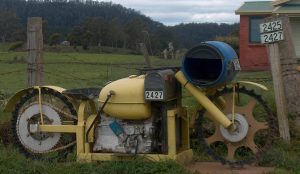 Until recently, fully one third of the island was in a protected forest, with no roads, no villages to disturb the natural beauty. In the last couple of years, some timber companies have been allowed into this area (a mistake in my opinion).
Until recently, fully one third of the island was in a protected forest, with no roads, no villages to disturb the natural beauty. In the last couple of years, some timber companies have been allowed into this area (a mistake in my opinion).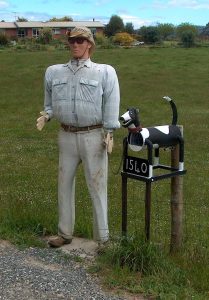
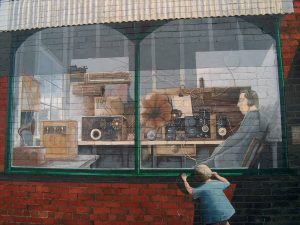 the midst of this, we came upon the town of Sheffield, often called Tasmania’s Outdoor Art Gallery. If we found a building with an exposed side wall, we would find a mural. The first mural in Sheffield was commissioned in 1986. Many of the pictures give aspects of the history of the town and Tas. We could not count all of the murals, but there must have been close to a hundred walls colorfully decorated.
the midst of this, we came upon the town of Sheffield, often called Tasmania’s Outdoor Art Gallery. If we found a building with an exposed side wall, we would find a mural. The first mural in Sheffield was commissioned in 1986. Many of the pictures give aspects of the history of the town and Tas. We could not count all of the murals, but there must have been close to a hundred walls colorfully decorated.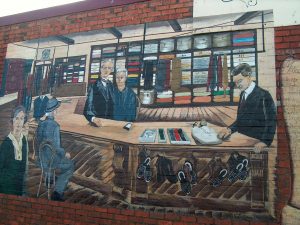 Keep in mind that Sheffield is a small town of approximately 1,400 people. However, it has become a major tourist attraction, with an estimated 200,000 visitors each year.
Keep in mind that Sheffield is a small town of approximately 1,400 people. However, it has become a major tourist attraction, with an estimated 200,000 visitors each year.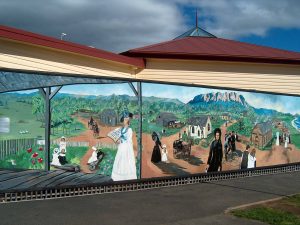 carved and the amazing use of hydro electric generation in Tasmania. Oh, and we must not forget the Tasmania Devils, the only thing we knew about the island (thanks mostly to Walt Disney)before we visited it.
carved and the amazing use of hydro electric generation in Tasmania. Oh, and we must not forget the Tasmania Devils, the only thing we knew about the island (thanks mostly to Walt Disney)before we visited it.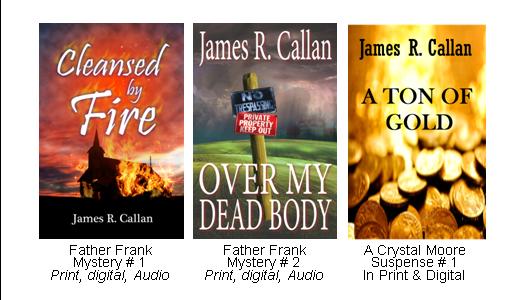

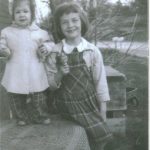 They were born, raised, and still live in the rugged area known as the Unorganized Territory in Main. They maintain a small farm, but (we know) their main goal is to produce great novels. They write “squarely to the hearts of real women who don’t always wear a size two and who prefer boots to high heels. And they believe some of the best stories are composed on the seat of a tractor. They will give a free copy of their latest book to a name drawn at random from those who leave a comment. Here are the Cuffe Sisters.
They were born, raised, and still live in the rugged area known as the Unorganized Territory in Main. They maintain a small farm, but (we know) their main goal is to produce great novels. They write “squarely to the hearts of real women who don’t always wear a size two and who prefer boots to high heels. And they believe some of the best stories are composed on the seat of a tractor. They will give a free copy of their latest book to a name drawn at random from those who leave a comment. Here are the Cuffe Sisters. We experienced ten seconds of fame once, when photographers from Down East Magazine took a picture of us roasting hotdogs at our island campsite. When we finally found the article, months later, we were surprised at the caption: Local campers cooking over an open fire. Even WE didn’t recognize ourselves!
We experienced ten seconds of fame once, when photographers from Down East Magazine took a picture of us roasting hotdogs at our island campsite. When we finally found the article, months later, we were surprised at the caption: Local campers cooking over an open fire. Even WE didn’t recognize ourselves!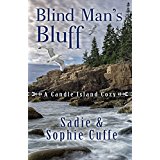 Come to Candle Island, hear the lonely cry of the gulls, feel the spray of the raging surf, and plant your feet on the bedrock ledges of Maine that have endured for millenia. We’re giving away a copy, so if you’d like to be entered in the drawing, all you have to do is leave a comment. Good luck, and thank you, Jim, for letting us visit!
Come to Candle Island, hear the lonely cry of the gulls, feel the spray of the raging surf, and plant your feet on the bedrock ledges of Maine that have endured for millenia. We’re giving away a copy, so if you’d like to be entered in the drawing, all you have to do is leave a comment. Good luck, and thank you, Jim, for letting us visit!